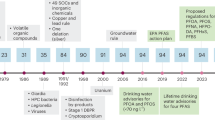Abstract
The National Center for Environmental Health (NCEH), part of the Centers for Disease Control and Prevention (CDC), and the Agency for Toxic Substances and Disease Registry (ATSDR) support and conduct research advancing national, state, and local public health response to per- and polyfluoroalkyl substances (PFAS). PFAS are a group of manufactured chemicals used in industry and consumer products that persist in the environment. Given the growing evidence linking PFAS with adverse health effects in humans, NCEH and ATSDR developed a public health research framework to capture the broad range of PFAS research activities being conducted and supported by the agency to determine future research priorities and identify opportunities for interagency collaboration. The framework was conceptualized via a multidisciplinary visioning process designed to identify compelling questions and research activities that span five scientific domains: toxicology, exposure, human health, public health action, and cross-cutting priorities. This paper presents a framework, compelling questions and research activities to help NCEH and ATSDR advance scientific discovery in partnership with federal, state, and local stakeholders as part of a comprehensive public health response to PFAS contamination.
This is a preview of subscription content, access via your institution
Access options
Subscribe to this journal
Receive 6 print issues and online access
$259.00 per year
only $43.17 per issue
Buy this article
- Purchase on SpringerLink
- Instant access to full article PDF
Prices may be subject to local taxes which are calculated during checkout


Similar content being viewed by others
References
Kudo N, Kawashima Y. Toxicity and toxicokinetics of perfluorooctanoic acid in humans and animals. J Toxicol Sci. 2003;28:49–57. https://doi.org/10.2131/jts.28.49.
Taves DR. Evidence that there are two forms of fluoride in human serum. Nature. 1968;217:1050–1. https://doi.org/10.1038/2171050b0.
Buck RC, Franklin J, Berger U, Conder JM, Cousins IT, de Voogt P, et al. Perfluoroalkyl and polyfluoroalkyl substances in the environment: terminology, classification, and origins. Integr Environ Assess Manag. 2011;7:513–41. https://doi.org/10.1002/ieam.258.
Wang Z, DeWitt JC, Higgins CP, Cousins IT. A never-ending story of per- and polyfluoroalkyl substances (PFASs)? Environ Sci Technol. 2017;51:2508–18. https://doi.org/10.1021/acs.est.6b04806.
Lau C, Anitole K, Hodes C, Lai D, Pfahles-Hutchens A, Seed J. Perfluoroalkyl acids: a review of monitoring and toxicological findings. Toxicol Sci. 2007;99:366–94. https://doi.org/10.1093/toxsci/kfm128.
Hu XC, Andrews DQ, Lindstrom AB, Bruton TA, Schaider LA, Grandjean P, et al. Detection of poly- and perfluoroalkyl substances (PFASs) in U.S. drinking water linked to industrial sites, military fire training areas, and wastewater treatment plants. Environ Sci Technol Lett. 2016;3:344–50. https://doi.org/10.1021/acs.estlett.6b00260.
Agency for Toxic Substances and Disease Registry. Toxicological Profile for Perfluoroalkyls. (Draft for Public Comment). Atlanta, GA: Agency for Toxic Substances and Disease Registry; 2018.
Sunderland EM, Hu XC, Dassuncao C, Tokranov AK, Wagner CC, Allen JG. A review of the pathways of human exposure to poly- and perfluoroalkyl substances (PFASs) and present understanding of health effects. J Expo Sci Environ Epidemiol. 2019;29:131–47. https://doi.org/10.1038/s41370-018-0094-1.
Calafat AM, Wong L-Y, Kuklenyik Z, Reidy JA, Needham LL. Polyfluoroalkyl chemicals in the U.S. population: data from the National Health and Nutrition Examination Survey (NHANES) 2003-2004 and comparisons with NHANES 1999-2000. Environ Health Perspect. 2007;115:1596–602. https://doi.org/10.1289/ehp.10598.
Steenland K, Fletcher T, Savitz DA. Epidemiologic evidence on the health effects of perfluorooctanoic acid (PFOA). Environ Health Perspect. 2010;118:1100–8. https://doi.org/10.1289/ehp.0901827.
Agency for Toxic Substances and Disease Registry. How is ATSDR involved investigating PFAS in the environment? 2019. https://www.atsdr.cdc.gov/pfas/atsdr_sites_involvement.html.
United States. Congress. House. Committee on Armed Services. National Defense Authorization Act For Fiscal Year 2018 : Report of the Committee on Armed Services, House of Representatives on H.R. 2810 Together with Dissenting Views (Including Cost Estimate of the Congressional Budget Office). Washington: U.S. Government Publishing Office; 2017.
Post GB, Gleason JA, Cooper KR. Key scientific issues in developing drinking water guidelines for perfluoroalkyl acids: contaminants of emerging concern. PLoS Biol. 2017;15:e2002855–e2002855. https://doi.org/10.1371/journal.pbio.2002855.
Hu XC, Dassuncao C, Zhang X, Grandjean P, Weihe P, Webster GM, et al. Can profiles of poly- and perfluoroalkyl substances (PFASs) in human serum provide information on major exposure sources? Environ Health. 2018;17:11 https://doi.org/10.1186/s12940-018-0355-4.
Rappazzo KM, Coffman E, Hines EP. Exposure to perfluorinated alkyl substances and health outcomes in children: a systematic review of the epidemiologic literature. Int J Environ Res Public Health. 2017;14:691 https://doi.org/10.3390/ijerph14070691.
Guelfo JL, Marlow T, Klein DM, Savitz DA, Frickel S, Crimi M, et al. Evaluation and management strategies for per- and polyfluoroalkyl substances (PFASs) in drinking water aquifers: perspectives from impacted U.S. Northeast communities. Environ Health Perspect. 2018;126:65001 https://doi.org/10.1289/EHP2727.
Cariou R, Veyrand B, Yamada A, Berrebi A, Zalko D, Durand S, et al. Perfluoroalkyl acid (PFAA) levels and profiles in breast milk, maternal and cord serum of French women and their newborns. Environ Int. 2015;84:71–81. https://doi.org/10.1016/j.envint.2015.07.014
Worley RR, Yang X, Fisher J. Physiologically based pharmacokinetic modeling of human exposure to perfluorooctanoic acid suggests historical non drinking-water exposures are important for predicting current serum concentrations. Toxicol Appl Pharmacol. 2017;330:9–21. https://doi.org/10.1016/j.taap.2017.07.001.
D’eon JC, Mabury SA. Is indirect exposure a significant contributor to the burden of perfluorinated acids observed in humans? Environ Sci Technol. 2011;45:7974–84. https://doi.org/10.1021/es200171y.
Shankar A, Xiao J, Ducatman A. Perfluorooctanoic acid and cardiovascular disease in US adults. JAMA Intern Med. 2012;172:1397–403. https://doi.org/10.1001/archinternmed.2012.3393.
Grandjean P, Heilmann C, Weihe P, Nielsen F, Mogensen UB, Timmermann A, et al. Estimated exposures to perfluorinated compounds in infancy predict attenuated vaccine antibody concentrations at age 5-years. J Immunotoxicol. 2017;14:188–95. https://doi.org/10.1080/1547691X.2017.1360968.
National Toxicology Program. Monograph on immunotoxicity associated with exposure to perfluorooctanoic acid (PFOA) and perfluorooctane sulfonate (PFOS). Research Triangle Park, NC: National Toxicology Program; 2016. https://ntp.niehs.nih.gov/ntp/ohat/pfoa_pfos/pfoa_pfosmonograph_508.pdf.
Buekers J, Colles A, Cornelis C, Morrens B, Govarts E, Schoeters G. Socio-economic status and health: evaluation of human biomonitored chemical exposure to per- and polyfluorinated substances across status. Int J Environ Res Public Health. 2018;15:2818 https://doi.org/10.3390/ijerph15122818.
Finch KC, Snook KR, Duke CH, Fu KW, Tse ZTH, Adhikari A, et al. Public health implications of social media use during natural disasters, environmental disasters, and other environmental concerns. Nat Hazards. 2016;83:729–60. https://doi.org/10.1007/s11069-016-2327-8.
English PB, Richardson MJ, Garzón-Galvis C. From crowdsourcing to extreme citizen science: participatory research for environmental health. Annu Rev Public Health. 2018;39:335–50. https://doi.org/10.1146/annurev-publhealth-040617-013702.
Funding
This report was by supported by funds from the Agency for Toxic Substances and Disease Registry, U.S. Department of Health and Human Services.
Author information
Authors and Affiliations
Corresponding author
Ethics declarations
Conflict of interest
The authors declare no competing interests.
Additional information
Publisher’s note Springer Nature remains neutral with regard to jurisdictional claims in published maps and institutional affiliations.
Rights and permissions
About this article
Cite this article
Rogers, R.D., Reh, C.M. & Breysse, P. Advancing per- and polyfluoroalkyl substances (PFAS) research: an overview of ATSDR and NCEH activities and recommendations. J Expo Sci Environ Epidemiol 31, 961–971 (2021). https://doi.org/10.1038/s41370-021-00316-6
Received:
Revised:
Accepted:
Published:
Issue date:
DOI: https://doi.org/10.1038/s41370-021-00316-6
This article is cited by
-
Maternal perfluoroalkyl and polyfluoroalkyl substances (PFAS) exposure and preeclampsia: a systematic review and meta-analysis
BMC Pregnancy and Childbirth (2025)
-
Identifying novel mechanisms of per- and polyfluoroalkyl substance-induced hepatotoxicity using FRG humanized mice
Archives of Toxicology (2024)
-
Determinants of maternal and neonatal PFAS concentrations: a review
Environmental Health (2023)
-
Identifying and sharing per-and polyfluoroalkyl substances hot-spot areas and exposures in drinking water
Scientific Data (2023)
-
Leveraging Systematic Reviews to Explore Disease Burden and Costs of Per- and Polyfluoroalkyl Substance Exposures in the United States
Exposure and Health (2023)



